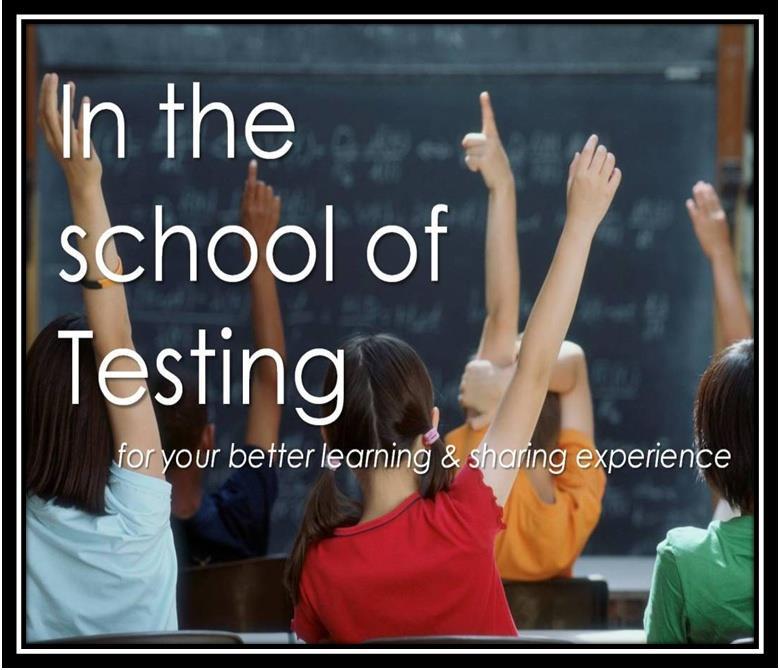
21 minute read
DO WE NEED BATMAN IF WE HAVE TESTERS?
- Astrid Winkler
Photo by Daniel Cheung on Unsplash
Advertisement
They say interesting things happen to you when you expect the least. I had such an interesting experience lately. If you are active on Twitter, some of you might have noticed my reports on Test Leadership Congress 2020. For those who don’t know, I am not a tester. When I was asked if I would like to write about my experience for the conference, I was unsure but excited. And with my official entry in this congress scene, I was testing the waters and trying to get the feel of the interesting world of software testing and tech-leadership which I was experiencing through this congress for the first time. If someone would have told me, “Hey, you are going to attend a conference in NYC this summer .” I would have said yea, sure. We are in a global pandemic, what exactly you did not miss? I was 100% sure, this water was too cold for me. But here I am after four weeks, writing an article about my understanding of the testing world. And I have built this understanding by attending a conference that should have been happening in New York but ultimately I attended from my cozy home office in Switzerland. I attended it on my computer, listening to and learning from great people from across different time zones. Thanks to the technology that made it happen. But, a HUGE thanks to the testers who made sure that this technology worked reliably. The more I reflect on my entire experience with technology, the more I realize that it is humans behind the technology who make sure that it works, against all odds. And hence I wonder, do we need Batman if we have testers? Attending this conference made me realize being a tester is not an easy job and for sure it takes one to be the master of the many trades. And here are some of the lessons I learned around what it takes to be a great tester (from the sessions that I could attend):
This has been my biggest take away from this conference. If you are a tester, you must not stop learning new things. In four weeks of the conference, I was exposed to so many different topics, themes, areas of the tech industry and to be a great tester means to be able to cope with all these dynamic and vast things. I can’t see any other way than a continuous learning attitude to make it happen.
The beautiful thing about learning is that nobody can take it away from you. - B.B. King If you ask me, what I got from attending the sessions is beyond valuable. Over the weeks I gained knowledge, confidence, and the ability to understand a topic, I didn't even know existed before. Can I use all this knowledge in my current job? Maybe not. Will it push me forward in the future? Possible. Will all this have an impact on me? Most likely YES.
People matter (the most)
Softwares are made ultimately for people and by people. And hence, testing better be human-centric. By people, I do not only mean the end-user but also the people in the team that work together to deliver software. And this fact kept coming up in some or the other form from different sessions that were delivered at the conference. For example - An interesting story shared by Dawid Pacia in his talk, “Startup meets quality - a short story of QA Game changer” emphasized the importance of valuing the employees and the teams. And how much it is important to work together as a team. The quote from Richard Branson stuck with me for long - “Clients do not come first. Employees come first. If you take care of your employees, they will take care of the clients.” The team-building workshop by Brittany Sherell was so much fun in a serious way which made me realize how important it is to grow as a private person also as a business person. And again, the importance of working as a team as she shared strategies to build a solid team: • Discuss team personalities and preferences (survey, a team meeting, etc.) • Collaborate as a team on how each member can use their strengths to contribute in the most powerful way. • Create an environment that welcomes two-way, continuous feedback
Communication is the key and giving Feedback is a skill
Good testing is incomplete without communicating about the information found in a way that people would be able to relate to. And so is one’s ability to give and receive feedback effectively. Multiple sessions shared this key message in a way and I can’t agree more. “Why is there a Marble on my Nose?” by Angela Riggs made me realize how important it is to understand that even at work, we can not separate our emotions from ourselves as an individual. People need time and space to get through their emotions. Negative emotions reduce people’s capacity for effective and productive work.
On communication skills, Angela said it is a way of transferring ideas, it happens whether or not we intend it to happen. Effective communication means adapting your communication style for different audiences. Communication makes us better testers because we have more awareness and control over the ways we share and receive information. On feedback skills, Mike Lyles said in his session, “Constructive criticism is imminent, but we should remember to praise in public and criticize in private. Giving and accepting feedback, honestly, holds the team accountable for continuous training and education with open door policy. There was another great session by Priyanka Halder where she shared the FBI Framework for communication and feedback: • F = Feeling: What emotion did the action or behavior of the other cause you? (Are you angry, anxious, sad, disappointed, or happy, surprised, thankful?) • B = Behaviour: What was the exact action that caused this emotion? (Note that you should not use the phrase “you always” or “you never”) • I = Impact: What were the consequences of this action?
Data is the new fuel
Data and hence test-data plays a critical role in testing effectively. Joshua Russell his session “Functional Test Data” emphasized this point. And honestly, this was one of my key sessions where I started to realize what is really happening behind the curtains. He recommended, to create the test data that tells a clear story, with believable details, and is carefully curated, including the use of personas. Well, this made me really happy actually. At that moment, I was convinced that the user-persona that I represent in my personal life is surely going to be part of someone’s test-data and thus making sure to consider my needs as a user.
Mindset is everything and Change is the only constant
Based on my learning about testing, by attending this conference for over a month, I learned that an important part of testing happens in the tester's mind and not really on their computer. Also, testers need to be flexible with changing contexts and changing their way of testing accordingly. Amy Jo Esser made an everlasting impression on me with her outstanding talk around change and mindset. In order to be the best version of ourselves, we need to change our habits which in turn can change our lives. Easier said than done, I know and this is why we need rules to guide us in the process of embracing the change. Amy Jo gave us three rules:
Rule One.
Make it a must. A Necessity. A non-negotiable. Create and write down a big why. It’s critical you master this skill/habit
Rule Two.
“Eat that Frog” first Brian Tracy has said, that your “frog” should be the most difficult task on your things-to-do list. The one you are most likely to procrastinate on.
Rule three.
Start tiny and atomic. Tiny habits and atomic habits. To change your habits and so your life seriously. On your journey always keep one thing in mind. “Every struggle s one step closer to greatness”
Christina Thalayasingam talked about Full Stack Testing which I believe also means that testers need to be flexible to cope with changes and work on their mindset to deal with those.
If you wonder “why should we go with full stack testing?”Christina answered that it is because we will have the ability to spot issues not just in functionally but any quality issue and that will enable us to narrow down bugs at an early stage. According to her, full-stack testing enables a quick feedback mechanism for every change. It is not required to rely on test teams working in silos and it creates business value by giving fast feedback loops on all layers of a technical process and always keep in mind, “You can't change your destination overnight, but you can change your direction overnight.”
Do not underestimate the power of Community
The community of Practice and Interests are powerful aids for testers to achieve desired culture change in the organization. At the same time, it matters that testers know how to contribute to communities and how to bring best out of those.
“How can we create links between different people?” you may ask. Emna Ayadi, in her session, answered this - we need to create a community of practice.
When groups are isolated (testers, developers, etc.) it’s easy to blame one particular group. Mixing the groups is effective for teamwork, which means to bring people together with the same interests but not the same skills. A Community of Practice is a combination of Community, Domain, and Practice.
In “Growing a Culture of Quality”, session Simon Prior talked about the first steps which need to be done to grow a culture of quality. Before changing the quality mindset in your organization, define where you are now and where do you want to be. Be clear on it and then you can define how to come from 1 to 2!
Automation helps but use it wisely
Paul Holland shared interesting stories with us. On automation in testing, he recommended asking - what is your biggest fear? Answer to this question gives us more input for our testing strategy and coverage of the required documentation. UI automation is often used too much and created by non-developers. When you take a tester away from testing and have them write automation you likely lose a good tester and gain a bad developer. Automation will likely not increase your coverage, decrease your costs, save your time, or allow you to reduce headcount. Unless you also increase risk. Automation can give you a decent sanity check of your product and execute in less time than a human performance the same checks. I could go on and on and write more about the fascinating world of testing. But I guess I should take a break here. Over one month of interesting experiences, knowledge exchange, and inspiration, I couldn't be more grateful, that I had the chance to be a part of this world and community. The testing community is very engaging which reflects in the way you support and help each other. The more I reflect on the key lessons I shared above, the more I start thinking of Batman who is my favorite superhero. I am very convinced that being great at testing requires practice, skills, courage, consistency, and a strong mindset. And Batman has it all. Which makes me wonder, do we need Batman if we have testers? A very special thanks to Anna Royzman and her team who did an amazing job organizing the conference and leading it in such difficult circumstances and never losing their smiles. I am looking forward to meeting you all again. Until then, stay safe, take care, and love what you do.
Astrid Winkler is a budding freelance journalist and content writer from Switzerland. She is currently working as a Project Lead for a creative adfirm based in Switzerland. Creativity is Astrid’s passion and writing is her lost-and-found love which she is willing to develop with more care. Astrid recently covered Test Leadership Congress conference by Test Masters Academy and has done very detailed reporting about her impressions. Feel free to checkout her reports for the conference starting from here.

Connect with Astrid on Linkedin or follow her on twitter @AstridWinkler4

A Human’s Guide to Testing AI


- Nilanjan Bhattacharya

Photo by Frank on Unsplash What does it mean to test AI? If you look at the spam detection feature in your email, it sometimes works, less often doesn’t. Even if you flag items as not spam, some again show up in spam after some time. You could categorize that as a machine learning FAIL? Amazon recommends books related to your purchase. Some of them make sense. Others don’t. Hopefully the algorithm learns and gets better over time. Are the incorrect recommendations a failure of the algorithm? Isn’t it expected that recommendations will learn and improve over time? So, failures are in fact not failures?
What does it really mean to test AI?
Do you test the way the algorithm ‘learns’ and improves? You could test with real world data. Are you testing the math? Can you test the math?
What is ‘AI’?
Providing a concise definition of AI (artificial intelligence) may be excruciating. The quote below is good enough context for this article (from a Human's Guide to Machine Intelligence).
AI involves enabling computers to do all the things that typically require human intelligence, including reasoning, understanding language, navigating the visual world, and manipulating objects. Machine learning is a subfield of AI that gives machines the ability to learn (progressively improve their performance on a specific task) from experience—the aptitude that underlies all other aspects of intelligence. If a robot is as good as humans at a variety of tasks but is unable to learn, it will soon fall behind. For that reason machine learning is, arguably, one of the most important aspects of AI. In the rest of this article, I use the term, ‘AI Software’. For the most part, the problems I describe are approached using machine intelligence. These algorithms use historical data to recognize patterns. Emails with text promising lottery wins are probably unsolicited spam.
Validate your hypothesis
Algorithms and the choices developers make have real world consequences. What is the purpose of a recommendation engine on Amazon? When you make purchases, recommendation engines will display related items. To test a recommendation engine, you may validate the relevance of the recommended items. That in itself is a very challenging problem. However, recommendation engines have a broader role. An expectation of recommendation engines is they promise that obscure titles will become popular. As a tester, how will you validate that hypothesis? You can validate your hypothesis by using a control group which isn’t exposed to recommendations. Then compare the actual users with the control group. Do users purchase more of the recommended items (compared to the control group)? Can you consider other factors? How does the purchasing behaviour change across all products? Can you look at market share as well as absolute sales? Do recommendations get new users to purchase products? Or is it the same users who are purchasing the same type of products? How will recommendation engines work, when books don’t have sufficient purchasing history? There are many more questions you can ask which can lead to further experiments.
Algorithm impact on user behavior
Algorithms can impact how people behave in the real world. That seems obvious with social media apps. How do you measure the influence of algorithms on social media apps? You could tweak an algorithm to show a different set of choices. Then measure user behaviour. In a research study, Facebook users were shown more hard-hitting news. These voters had a higher voter turnout. You could alter recommendations shown to users along with a control group. Then measure user behaviour. In another study, Facebook users were shown more positive and more negative posts. User’s subsequent posts reflected the emotion of their news feed.
A Human’s guide to Machine Intelligence
In the last few years, AI FAILS have been a novelty mixed with indignation. It’s easy to find examples of failures in the news. In contrast, the book, ‘A Human’s guide to Machine Intelligence’, is a very readable account of why algorithms fail. In this blog post, I’ve posed some of the questions, from the book, that you might ask if you were evaluating algorithms as a software tester. The book has detailed analysis and explanations of how algorithms fail and the background on some of these questions. The focus of the book is not on the math, but how algorithm design choices can cause problems in the real world.
As a software tester, it’s better to focus on strategies to test AI, or personal accounts of how you have tested AI algorithms.
What is testing AI?
Testing starts with an observation or an idea. You then validate your idea by conducting an experiment. • Facebook researchers have a hypothesis that social media posts influence user behavior. • A software developer notices that businesses are not getting good SEO rankings. • A user complains that his email suddenly flags messages as spam.
These observations are followed by an experiment. The approach to testing AI is probably no different from testing other software. When testing a calculator, I wonder whether it assumes numbers are entered in a particular format. Does it accept ‘.03’ without the leading zero (0)? If it doesn’t, does it matter? I can test out different options to infer what the calculator does. This does not mean testing AI is straightforward or even possible in your role as a tester. Testers or developers may not be part of the group conducting tests with users. On the other hand, in smaller teams any team member may be able to ask questions. They may be part of the group which reviews experiments with users.
Unanticipated consequences
When working with complex algorithms, especially those that use real world data, you need to think about side effects or unanticipated consequences. In a, now, well-known problem, when using autocomplete on a search engine, users are prompted with common prejudices. Entering, ‘women should’, may display suggestions such as ‘women should stay at home’. A search engine’s auto-complete may not only offer harmful suggestions, but direct users to those sites. The unintended consequence of auto-complete is that users may be led to sites which give harmful messages. A seemingly harmless enhancement such as auto-complete on a search engine can influence people’s attitudes and can impact society as a whole. (As an aside, how do you design systems to address this issue?) When designing auto-complete or similar systems, a bigger challenge is how do you differentiate between concepts, such as porn and sexuality? Does your algorithm understand the difference between concepts, or are they just words? On some social media sites, you are alerted about offensive language. How do you handle names or locations which may include offensive words? One way to handle the issue is to ignore proper nouns when alerting users – which itself may be a challenge. If you do allow proper nouns, how do you handle attempts to misuse the system?
Social media sites like Facebook and Linkedin create trending topics and feeds. How do you handle the presence of ‘fake news’ in the feed? Do you question the credibility of news sources? Do you question whether someone can tamper your data? To be fair, many of these questions may not be in the purview of the development team or of software testers. However, this post should give ideas about the questions that you could ask if you can influence decisions.
Real World Data
Problems solved using AI often use a large amount of real-world data. Real-world data will have its quirks which are difficult to anticipate in the lab. You can only go so far in simulating a Facebook feed (which does not imply that you do nothing, or that there aren’t powerful alternatives). Problems solved using AI often use social data – information related to people’s lives. Facebook and similar apps use friend details and activity and user interaction, information related to social groups. Other systems impact business, such as automated trading, or a social feed on a financial website, book recommendations or search engine rankings. Advertising systems affect consumer behavior. In the case of auto-complete, in a search engine, you need to handle loaded topics, like race, gender, religion. You also need to consider people wanting to mislead gullible users. Image recognition is not only about pixels, but about people and their gender, race and location. Not being able to use real world data is a major challenge for testing AI software.
The problem with testing AI
Some of the most important insights about testing AI from the book are: We should look beyond the accuracy of algorithms.
But we generally don’t evaluate, let alone measure, algorithms holistically, considering all the ways in which they change their users’ decisions—individually or in aggregate.
We should think about unintended consequences.
Most other algorithms continue to be evaluated narrowly using one or two technical criteria and without regard to the kinds of metrics that keep social scientists awake at night—issues such as fairness, accountability, safety, and privacy. Unintended consequences can arise even when every step of an algorithm is carefully designed by a programmer.
These are my insights when I add an understanding of testing: • The start of a test is the question we ask. A question may come up from exploration, experiments or from a problem faced by the user. • In general terms, you will need to be creative, as opposed to following a process, to ask the right questions. • Whether you ask the question is much more important than who asks or when you ask. • Asking the question is more important than what led you to ask the question – whether it is the use of tools or a thought experiment. • The examples I have described in this article are definitive, i.e., there is a clear hypothesis followed by an experiment. The actual process of testing (and thinking) is much more fluid and situational. The result of experiments lead to more questions and more experiments. You may also investigate multiple questions. You may use the software, like a user would, to discover more problems. The overarching purpose of testing is to keep learning about the software in order to find unknown risks. For an article like this, there is no big reveal. I didn’t focus on specific techniques. I also didn’t promise a theory which explains everything. I won’t be smug that testers or developers can test AI based software, if only we ask questions or are inquisitive. Good testing will require preparation along with aptitude. Finding problems will also require a strong understanding of AI and the related algorithms. The problem with testing AI is not mistakes or oversights. The challenge is unintended consequences. The problem is with algorithm design choices and their impact on the real world and users. The broader problem with testing AI is not recognizing that we need to ask questions and keep learning. It’s the same problem with testing any other software. Just as with software in general, it may not be apparent that there is a problem to be solved.
Notes
1. A Human’s Guide to Machine Intelligence, Kartik Hosanagar, Guide-Machine-Intelligence-Algorithms/dp/0525560882 https://www.amazon.com.au/Humans
2. Kartik Hosanagar is a professor of Marketing at The Wharton School in the University of Pennsylvania. He lists research interests as: internet advertising, e-commerce, digital media. Links: Personal website, Twitter. 3. If you are not a tester, this is a great article to understand testing: https://www.linkedin.com/pulse/howcem-kaner-testssoftware-nilanjan-bhattacharya/(All credit goes to the original author – Cem Kaner.) 4. If you want to understand testing, without reading much, you can follow Michael Bolton on Twitter: https:/ /twitter.com/michaelbolton/He tweets frequently and more importantly, many of his tweets are profound. For more, you can read his blog –www.developsense.com/blog. Another thought leader in testing is James Bach –www.satisfice.com/blog. I recommend the Kindle version of the classic and easy to read book on testing: https://www.amazon.com/Lessons-Learned-Software-Testing-Context-Driven-ebook/dp/B07MGKRDBY
Nilanjan works in DevOps Delivery in Sydney. Nilanjan has a background in software testing and project management. He has worked with a variety of software teams, including software product teams. His experience in analyzing customer support issues and working with successful software products with a multi-year lifecycle, provides a unique perspective on software quality and defects.

Nilanjan maintains a blog on Medium (https://medium.com/ @revelutions) and can be reached on Twitter (https:// twitter.com/nilanjanb) or Linkedin (https://www.linkedin.com/ in/nilanjanswmanager/).
Secure your spot today. Contact us at sales@teatimewithtesters.com





